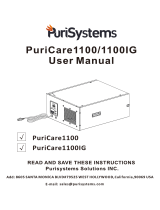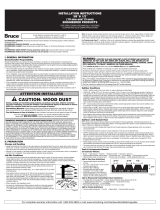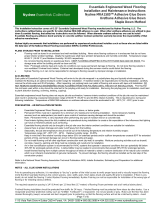
MOHAWK TECHNICAL SERVICES - HARD SURFACE I MOHAWK TECH@MOHAWKIND.COM I 888-387-9881 0616 | JB | 07/2022 | 1 of 9
TECWOOD ESSENTIALS | SELECT | PLUS
INSTALLATION INSTRUCTIONS
For TecWood Floors With Ply Construction
Engineered hardwood ooring can be installed over most properly prepared sub-oors and are engineered to be dimensionally stable, making them suitable
for installation on all grade levels where excessive moisture conditions do not exist. We continuously make technological advancements that improve product
performance or installation techniques and methods. To conrm you have the most recent installation instructions, please visit our website at mohawkooring.
com or contact Technical Services at 888-387-9881.
Caution: Wood Dust
Cutting, sanding or machining wood products produces wood dust. While wood products are not hazardous under the OSHA Hazard Communication Standard
(29 CFR 1910.1200), the International Agency for Research on Cancer (IARC) and the State of California have classied wood dust as a human carcinogen.
Precautionary measures: Airborne wood dust can cause respiratory, skin and eye irritation. Power tools should be equipped with a dust collector. Use an
appropriate NIOSH-designated dust mask. Avoid dust contact with skin and eyes.
First aid measures in case of irritations: In case of irritation, ush eyes with water. If needed seek medical attention. If dermatitis occurs, seek medical attention.
To request Safety Data Sheets contact Mohawk Technical Services at 888-387-9881.
WARNING: Drilling, sawing, sanding or machining wood products can expose you to wood dust, a substance known to the state of California to cause cancer.
Avoid inhaling wood dust or use a dust mask or other safeguards for personal protection. For more information, visit: www.P65Warnings.co.gov/wood
WARNING! DO NOT MECHANICALLY CHIP OR PULVERIZE EXISTING RESILIENT FLOORING, BACKING, LINING FELT, ASPHALTIC “CUTBACK” ADHESIVES OR
OTHER ADHESIVES. Refer to www.rfci.com for Recommended Work Practices for Removal of Resilient Floor Covering.
IMPORTANT HEALTH NOTICE FOR MINNESOTA RESIDENTS ONLY: These building materials emit formaldehyde. Eye, nose, and throat irritation, headache,
nausea and a variety of asthma-like symptoms, including shortness of breath, have been reported as a result of formaldehyde exposure. Elderly persons and
young children, as well as anyone with a history of asthma, allergies or lung problems, may be at greater risk. Research is continuing on the possible long-
term effects of exposure to formaldehyde. Reduced ventilation may allow formaldehyde and other contaminants to accumulate in the indoor air. High indoor
temperatures and humidity raise formaldehyde levels. When a home is to be located in areas subject to extreme summer temperatures, an air conditioning
system can be used to control indoor temperature levels. Other means of controlled mechanical ventilation can be used to reduce levels of formaldehyde and
other indoor air contaminants. If you have any questions regarding the health effects of formaldehyde, consult your doctor or call your local health department.
Installer/Owner Responsibility
It is the responsibility of the installer/owner to ensure that job site environmental, suboor and subsurface conditions involved meet or exceed all requirements
as outlined in installation instructions prior to installation. Manufacturer declines all responsibility for product performance or installation failure due to suboor,
substrate or environmental deciencies or jobsite conditions.
All wood continually expands and contracts until it reaches moisture equilibrium with the environment in which it’s installed. As with all wood ooring,
expansion and contraction will be minimized if the interior relative humidity is consistently maintained year-round. Humidication and/or dehumidication
systems may be necessary to maintain your home environment to prescribed relative humidity conditions.
The owner/installer assumes all responsibility for nal inspection of product quality. Examine ooring for color, nish and style PRIOR TO INSTALLATION. If
material is unacceptable, contact the seller immediately. Wood is a natural product and contains characteristics such as variations in color, tone and graining.
Flooring is manufactured in accordance with industry standards, which allows manufacturing and natural deciency tolerances up to 5% of the total installation.
Installer should blend ooring from minimum of three cartons at a time to ensure good color and shade blend. The installer must use reasonable selectivity
and hold out or cut off pieces with deciencies. Do not install undesirable pieces. Flooring warranties DO NOT cover materials with visible defects once they are
installed. Installation is acceptance of product quality. Check carton labels for lot numbers. Lot numbers should not be mixed.
All work involving water or moisture, e.g. plumbing, masonry, painting, plastering, etc. must be completed prior to ooring being delivered. Building
envelope must be complete and exterior doors and windows installed. Exterior grading and gutter downspouts should be completed and permanent HVAC
systems in operation.
Precautions should be taken to protect oors from other trade work. Do not cover oors with plastic, red rosin, felt or wax paper or previously used cardboard.
Instead use a breathable material such as clean, dry, plain uncoated cardboard or construction paper. Inks from printed cardboard could damage the hardwood
oor. The oor should be thoroughly cleaned before covering to remove grit and debris that would damage the nish. The oor must be completely covered
to eliminate uneven ambering from exposure to UV light. Remove covering immediately after other trades are nished to avoid moisture damage from
condensation. Warranties do not extend to damage caused by trapped moisture.
Permanent HVAC should be on and operational for a minimum of 5 days and maintained between 65° and 75°F with a relative humidity of 35% to 55% prior to
delivery, during and after installation of the ooring for the life of the product. If HVAC is not possible at time of installation, the environmental conditions must
be at or near normal living conditions between 60° and 80°F and at the average yearly relative humidity for the area.









 1
1
 2
2
 3
3
 4
4
 5
5
 6
6
 7
7
 8
8
 9
9
 PuriSystems PuriCare 1100 Air Filtration System User manual
PuriSystems PuriCare 1100 Air Filtration System User manual
Pergo LEW47-69 Installation guide
Pergo 830236 Installation guide
 Bruce EAHHD75L402 Installation guide
Bruce EAHHD75L402 Installation guide
Shaw DH83300879 Installation guide
TrafficMASTER DH83300941 Installation guide
Shaw DH77900166 Installation guide
Shaw DH85507018 Installation guide
Shaw DH83400326 Installation guide
 Nydree Flooring FPTBORO01QD4BDM Installation guide
Nydree Flooring FPTBORO01QD4BDM Installation guide











